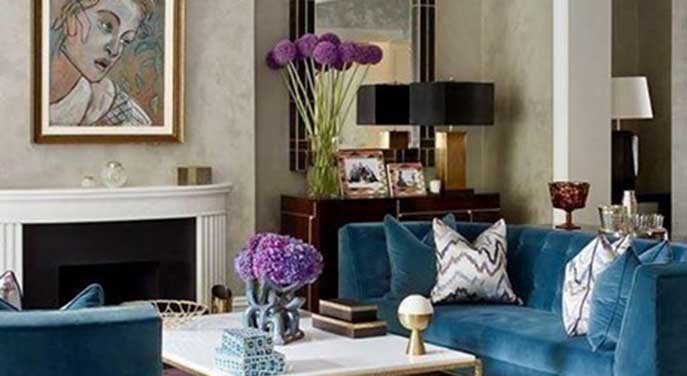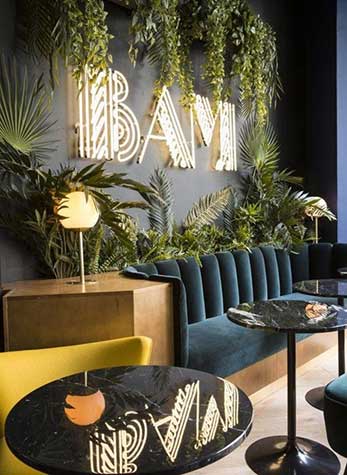No design era speaks of futuristic sophistication and glamour like that of the Art Deco architecture and lighting. A timeless infusion of decorative elements, Art Deco originated in the 1920s and 1930s and still finds its place in modern architecture and interior design. As the immediate successor of the Art Nouveau era, the Art Deco movement began in the 20th Century, with an aim to modernize some of the design elements of the previous era.
The Art Deco movement further evolved in the 1960s with the rise of Pop Culture, integrating bold colors and patterns in its design. The luxurious Art Deco as we know it today only became a defining element of this movement in the 1980s, with lavish incorporation of metallic and opulent architectural finishes to make a statement.
In the present day, Art Deco has progressed seamlessly into the modern maximalist design, carrying along its bold application of colors and incorporation of luxurious elegant handcrafted pieces in its décor.
Characteristics of the Art Deco Design
How can tell apart an Art Deco Design? Well, the following combinations of features are key identifiers that are unique to the Art Deco design.
● Incorporation of Geometric Shapes and Patterns
The Art Deco Style features geometric shapes and angular patterns such as the chevron and zigzags in its design. Repetition of these shapes and patterns are evident in the furniture, flooring, light fixtures, and tapestries.
● Addition of Embellishments
In its effort to achieve an elegant look of lavishness and extravagance, Art Deco integrates decorative jewels, glass, gemstones, and precious metals in a tasteful fashion to create statement furniture and lighting pieces. It accessorizes with polished stunning metals such as gold, bronze, stainless steel, silver, or brass to curate its one-of-a-kind pieces.
● Sleek, Modern Style
Art Deco has remained relevant from its inception because of its modern and futuristic look that still blends flawlessly into the modern interior design. Its application of glossy finishes, shiny metallic details, and clean, angular shapes are perhaps the secret behind its timelessness.
● Grandeur
The Art Deco style aims to impress in every single piece it incorporates. From the furniture to the decorative items and the lighting, every piece is uniquely curated, adding a dramatic effect to the space. Glamour is seen in every captivating piece, boldly standing out due to their conspicuous colors and patterns, their contrastingly outstanding sizes, impressive embellishments, or their polished material options.
How to Incorporate Art Deco into your Interior Design
Having understood the various characteristics of the Art Deco design, there are a number of elements you can incorporate into your interior spaces to effortlessly achieve this style. Below are some of the Art Deco elements and professional tips for hacking this elegant flair.
1. Art Deco Furniture
You can never go wrong with Art Deco furniture in your home. Go for exceptional embellished pieces made of sophisticated materials such as leathers, mahogany, mirrors, polished lacquer finishes, and metallic accents. It might be quite expensive to acquire original Art Deco furniture, but you can recreate the design according to your budget.
2. Art Deco Colors
The simplest way to instantly transform your modern space into an iconic Art Deco masterpiece is through color. Since Art Deco integrates bold colors coupled with neutral colors in its color palette, you can achieve a good balance of both in your design.
If you’re going for the classical Art Deco look, simply use black and white colors in bold patterns for a polished, monochromatic look. However, to attain a more modern and color-coordinated scheme, you need to add brown, cream, beige, or other earthy neutrals to your design, topping it with bold colors in your accents.
Royal Purple, Blues, Yellows, Pinks, Greens, and Red Hues are some amazing colors to add as a splash of elegant luxury for the complete Art Deco look.
3. Art Deco Wallpapers
Wallpapers have made a massive comeback and are currently trending in the interior design field, with mass production of countless designs from which to select. Choosing an Art Deco wallpaper is therefore an easy way to achieve this style and elevate your interior space. Go for wallpapers with metallic details of gold or silver, geometric shapes and angular patterns, or bold and brilliant colors, to stick to the theme of this style.
4. Art Deco Lighting
Modern Handmade Rugs, Rug’Society, via Pinterest
Art Deco played an important role in the development of the lighting industry. Having originated at a time when electricity had just become available, Art Deco saw the production of various light fixture designs, becoming an integral part of the Art Deco style. The following are some of the features of the Art Deco lighting:
● Materials and Design:
The Art Deco light fixtures embraced the use of glass, reflective metals, and porcelain. They were made into sleek but grand fixtures that integrated symmetry in the use of geometric shapes and patterns. Art Deco fixtures are dramatically long with simpler angular shapes as compared to the preceding Art Nouveau era, which worked with meticulous organic motifs.
● Light Fixtures:
Art Deco light fixtures include wall sconces, ceiling lights, and showstopping chandeliers made in simple geometric shapes and patterns. The luminaires come with a glass or porcelain lamp shade for diffused lighting, and metallic frames.
● Uplighting
With the experimentation into lighting and various lighting designs at the onset of the Art Deco era, uplighting became a popular technique for adding indirect lighting into a room. Incorporate an uplighting fixture into your design, allowing the light to reflect off the ceiling for soft lighting.
● Neon Lighting
At the prime of Pop Culture in the 1980s, the Art Deco movement embraced the use of colorful neon lights to the architectural exterior. This particularly applied to commercial buildings and luxurious leisure facilities for the young upper class. Neon lights are still commonly used in advertising signages and branding in commercial spaces, propelled by the manufacture of LED lights in various colors.
In Conclusion
The Art Deco style is a sophisticated and elegant design choice that still has its place in modern décor. You can easily achieve this style by adding the above Art Deco elements into your residential and commercial spaces.
With regard to Art Deco lighting, you can get quality exquisite pieces in antique and polished metallic finishes from Perfect Picture Lights. The Bronze, Gold, Nickel, Brass, Chrome, mixed metals, and painted finish options will all go perfectly with the Art Deco look. You can bring life to your Art Deco artworks with an intimate antique picture light, or invest in an uplight fixture for a more dramatic effect.
Winny Okoth is a practicing Construction Project Manager and Interior Designer. She is also currently pursuing her Master’s Degree in Construction Project Management. Winny Okoth has a great passion for every form of design, the mastery of principles of design, and 3D visualizations skills for architectural and interior design.
This content is a joint venture between our publication and our partner. We do not endorse any product or service in the article.














